
BIOL 103
Kenyon College
 |
Slonczewski
Home
BIOL 103 Kenyon College |
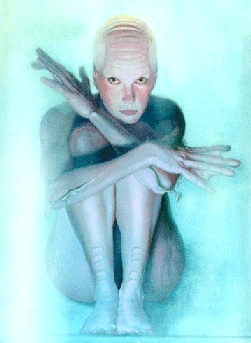
Alan Pollack, cover for Tor Books reprint |
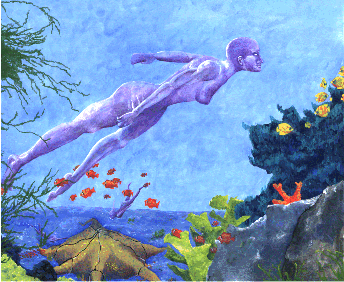
Rowan Williams art site, A Door into Ocean |
To appreciate the context, Ocean was written during the early eighties, at the height of the Reagan era, when the very survival of the planet was threatened by nuclear winter. Peace was thought unattainable; anyone who even suggested that repressive socialist governments might be overthrown peacefully was viewed with suspicion. Advocates of noncooperation with draft registration risked a $5,000 fine. Women's rights and environmental concerns were considered a hangover from the sixties. Secretary of the Interior James Watt began selling off national forests.
An early version of Ocean was rejected by two publishers, one of whom derided it as a "fairy tale." When Ocean was finally accepted for publication, I felt too discouraged to include any acknowledgement or dedication. A decade later, an acknowledgement and dedication were provided for the Tor reprint, but they got lost in production. The dedication was intended for my parents, John and Esther Slonczewski. The intended acknowledgement was for editor David Hartwell, for his editorial encouragement and support. I also wish to thank SFRA members Betty Anne Hull and James Gunn for their longstanding support.
This study guide addresses common questions of biological and political science that are developed in A Door into Ocean. As a biologist, I have always viewed political theory--optimistically--as a subfield of animal behavior. Discoveries in animal behavior of the past twenty years have confirmed that animals are equally capable of altruism as are humans, and that moral codes of behavior that aspire to altruism are entirely compatible with human biology.
Gender
polarities and language.
In literary terms,
A
Door into Ocean sets up a series of interlinked polarities or
binary
oppositions, all of which relate to traditional notions of
female/male.
Each of these oppositions is deconstructed or resolved through the
course
of the story. It is important to note that the story does not
conclude,
for example, that female is superior to male; when characters express
such
views, they are shown to be mistaken. The course of events is
initiated,
driven, and largely resolved through Merwen’s quest to adopt a male
Valan
and prove that he is equally human to Sharers.
The more significant
of these polarities are summarized in the following table:
| Positive/
Progressive |
Negative/
Regressive |
Nature of Opposition | Means of Resolution |
|
|
|
Female Sharers appear physically inferior, spiritually superior to males. Male Valans, at first, are called "sick" or "malefreak," or are considered inhuman animals. | Certain male characters (Spinel, Siderite) learn the Sharer strengths, including whitetrance. Female characters (Berenice, Jade) show strength and weakness more typical of male Valans. |
|
living things |
stone death |
All
Sharer technology is based on living creatures or their
products (such
as seasilk, shells, raftwood). They call the Valans "dead"
because they
dwell on land.
Sharers cannot comprehend the existence of solid rock or land, just as they cannot imagine male human beings. The experience of these substances drives some individuals insane. |
Spinel explains to the Sharers his own understanding of rock and stone; he is trained as a stonecutter. Some of the Sharers learn how to dwell on land. Spinel’s ability to learn Sharer ways convinces them that he is not "dead." |
|
(Ecology, Biological Chemistry) |
(Physics, Inorganic Chemistry) |
In the 19th and most of the 20th centuries, biological sciences were considered softer, less rigorous, and more female-appropriate than the "hard science" of physics and inorganic (non-carbon) chemistry. Today, the distinction has been replaced by a full continuum of rigorous inquiry spanning these disciplines, and incorporating feminist insights into all of them. However, the old belief still persists in the failure of some critics to recognize biologically based SF as "hard science fiction." | One of the Valan soldiers teaches the Sharers how inorganic materials relate to the structure of their own bodies; for example hemoglobin, the oxygen carrier protein of our blood, contains iron, the same element present in the soldiers’ weapons. |
|
|
|
At first, Sharers believe Valans are alien beings, non-human--and Valans think the same of Sharers. | Spinel convinces Sharers he is human; and Merwen convinces General Realgar (despite his resistance) that she is human. These gradual conversions occur by classic strategies of nonviolent action. |
|
|
|
Sharers consider Valans "sick" because of their violence and apparent immaturity. | Sharers such as Rilwen, Yinevra, and even the Sharer-trained Valan, Berenice, show the possibility of failure. On the other hand, Spinel, Siderite, and a number of Valan soldiers are apparently "cured" of the sickness. |
|
Strong
|
Weak (inside) |
Sharers appear weak because they are female and unclothed, but they have inner strength based on nonviolence and whitetrance. Valans appear strong because they are male and armed, but they lack spiritual authority. | As the story progresses, both Sharer and Valan characters, female and male, show capacity for strength and weakness. |
|
|
|
Valan language, like ours, distinguishes between subject and object. Valans try to force Sharers to recognize the Valan invaders as the subjects turning Sharers into objects. | Sharer language sees no distinction. Every subject and object are interchangeable; they "share" the action. Thus Sharers can prevent Valan control by failing to "share" their demands (that is, failing to obey orders.) Sharer language plays a crucial role in deconstructing all the polarities above (further discussion below). |
The deconstruction of polarities is mediated in part by the unique language of the Sharers which conflates subject and object. The distinction between subject and object is fundamental to nearly all human languages, although interestingly, less so in English than in many others. In English, the difference between subject and object relies largely on word order ("Man bites dog" versus "Dog bites man") yet even word order is ambiguous.
The widespread acceptance of object-subject polarity is perhaps surprising, given that this concept has surprisingly little basis in physical or natural science. In fact, Newton’s law states that every action has an equal and opposite reaction; that is, if a hammer hits a nail, the nail (and the object attached to it, and indeed the entire Earth) hits the hammer. What is interesting from a psychological point of view is the profound insights that may be reached when one dissolves the subject-object distinction. For example, when an unborn child exists within a mother, "the mother exists within the child." This is literally true; much of the mother’s substance forms the substance of the child, and this understanding is fundamental to prenatal medicine. Women who smoke or consume unhealthy substances fail to appreciate this phenomenon.
Because of their language, Sharers take for granted that any harm done to a person is shared by the perpetrator; if someone’s action leads to the death of another, the murderer/survivor is as "dead" as the person physically killed. Thus, Sharers literally cannot imagine one human being forcing another to behave against her will. Their own system of governance does not even allow for such. Because they cannot force others, they cannot be forced by others. Thus, they practice naturally the doctrine of "satyagraha," love-force, developed by Gandhi and other historical practitioners of nonviolent resistance.
Responses
to Classic SF.
Much
of
A Door into Ocean reflects my responses to Frank Herbert's
Dune,
and to Ursula LeGuin's
The Word for World is Forest. Dune
depicts a world covered entirely by desert. To a biologist,
the limitations
of such a world are clear; no desert ecosystem can exist without
moisure
evaporated from ocean and carried by air currents. It was a
natural
step to imagine the opposite, a world covered entirely by water,
which
the Earth may well have been early in our planet's history.
Dune depicts several male-dominated societies whose members scheme and oppress one another. The psychology of the characters is compelling, and study of it was helpful for me. Nevertheless, the societies in Dune are all limited to those dominated by males and violence. (Even the female Bene Gesserit use violent means, and direct most of their scheming toward manipulation of males.) Thus, in Ocean I attempted to oppose the Dune concept by depicting ocean-dwelling females in nonviolent revolution, who succeed without losing their humanity--as Paul and the Fremen sadly do.
The Word for World is Forest is a more direct predecessor of Ocean. Forest started out as my favorite of LeGuin's books, but in the end was an intense disappointment. LeGuin's forest-dwellers start out as unconditional pacifists, with inborn mechanisms of self-discipline similar to those of the Sharers; but in the end, in order to throw off their oppressors, they, too must give up their pacifism and their own humanity; the ending is even more bleak than Dune. In Ocean, I imagined a "forest" turned upside-down: the trees stretch their branch/roots into water, an endless source of life and power. The Sharers use this power, enabled by their superior genetic technologies, to maintain their way of life. Their own nonviolent politics overcomes the oppressor (see below).
Another less obvious influence was that of Robert Heinlein's The Moon is a Harch Mistress. This book impressed me for its sense of humor in depicting the lunar community throwing off their colonial masters. In fact, actual totalitarian societies such as the former Soviet Union have always fostered considerable amounts of humor as a coping mechanism and as a subtle (or not so subtle) means of subversion. Unlike some other Cold War-influences writers, I have always tried to follow Heinlein's example in showing the humorous aspects of political struggle.
Cephaglobinid
creatures: Divergence or Convergence?
The
planet
Shora hosts a unique family of marine creatures,
"cephaglobinids."
These are modeled after cephalopods
such as the octopus
and
squid.
Australian Giant Cuttlefish, by Mark Norman |
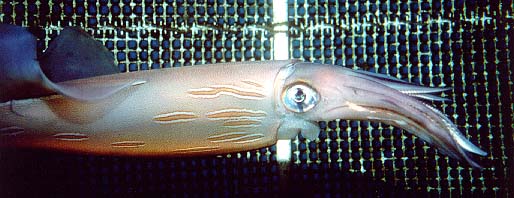
Squid,
Loligo
forbesi, a Mediterranean delicacy, by Peter Wirtz.
|
The difference is that cephalopods on Earth have blue blood, from a copper-containing blood pigment called h(a)emocyanin. Hemocyanin carries oxygen less efficiently than the iron-containing hemoglobin of vertebrates. On Shora, these animals have evolved a blood pigment "cephaglobin" which contains iron and enables a higher rate of metabolism. Thus, cephaglobinids have evolved to great size (the seaswallower) and to greater capacity for speed, even rocketing out of the water (rocket squid.)
From the standpoint of science fiction, A Door into Ocean is exceptional in depicting divergent evolution of a wide range of species, instead of just one unusual creature (such as the great worm of Herbert's Dune.) Divergent evolution refers to the generation of two or more distinct species from a common ancestor. For example, all mammals have diverged from a common mammalian ancestor back at the end of the age of dinosaurs. Cephaglobinids such as the seaswallower, the rocket squid, and the starworm, all have diverged from a common ancestor.
Examples of convergent evolution are more common in science fiction--far too common. Convergent evolution occurs when two unrelated species evolve to share similar traits because each species has independently adapted to similar ecological conditions. For example, the "flying fish" of Shora evolved to fit the aerial habitat filled on Earth by birds (descended from dinosaurs) and bats (descended from mammals). The problem with evolution in science fiction is that too often when creatures or people from two different planets meet, they are instantly able to interbreed. This would never happen--convergent evolution never brings two genetic lineages together to be able to match up their chromosomes. Interbreeding between alien species is rarely explained adequately in science fiction; one exception is the remarkable book Dawn, by Octavia Butler (see essay on biology in Dawn.)
An aspect of evolution not discussed in A Door into Ocean is that of biochemical compatability between Earth creatures and those of an alien biosphere. In A Door into Ocean, Spinel from Valedon can immediately eat and enjoy the plants and animals of Shora, many of which largely resemble Earth organisms. Apparently they all contain DNA and the same twenty amino acids that make up our proteins, the building blocks of terrestrial life. This can only be explained if the Sharers have systematically replaced most, if not all, of the pre-existing ecosystem of Shora with Earth-evolved organisms--in other words, in their own way they must have terraformed Shora, just as Valedon was terraformed. This problem bothered me, and I addressed it obliquely in the next book, Daughter of Elysium. Later The Children Star presents an alien planet with a biochemistry completely different from Earth, and toxic to humans (see Study Guide).
Raft
trees.
Sharers dwell upon
giant raft trees, building silkhouses upon them and tunneling into
them
where they conduct "lifeshaping" science. The raft trees are
"hydroponic;"
they grow by extending buoyant roots deep into the water, then putting
out leafy branches above. Instead of growing a tall phallic
trunk,
a raft tree grows in girth, wider each year. Blossoms from its
branches
produce seeds for new trees. Of course, like trees on Earth,
most
of the seedlings get eaten before they grow large. Those which
do
grow into trees provide habitats for enourmous quantities of wildlife:
corals, legfish and flying fish, starworms, fleshborers, shockwraiths.
The Sharers hollow out homes within the raft, and build structures upon it. Another vital function of the raft (revealed late in the narrative) is to store the entire library of Sharer information in its genome--that is, within the chromosomal DNA of every cell. Thus the Sharers can never lose their essential history and knowledge because every cell of every raft tree contains all the knowledge they possess. How this knowledge gets updated is not addressed. Presumably Sharers use the clickflies to transmit information-coding genes in infective vectors (genetically engineered carrier viruses) which transmit the new DNA into the chromosomes of the tree. Today, contemporary genetic engineers are modifying the deadly HIV virus (cause of AIDS) to carry new genes into humans.
The idea of a raft
tree originated from my upbringing in a wooded area of New York.
In the sixties, children were not so programmed into activities as
they
are today; I spent much of my summers roaming the forest, sometimes
resting
on my back in a clearing to watch the trees reach into the sky.
I
imagined that the branches reaching into the blue sky were actually
roots
reaching down into an endless watery abyss, upon which the entire land
of Earth floated.

Pennsylvania landscape by Silvere Boureau |

Same landscape, seen from upside-down |
Another source of
inspiration
for the raft trees was that of mangrove
forests. Mangrove trees hold soil and support the
world's
most fertile wetland ecosystems in South America, Asia, and
Australia.
In these watery forests, people gather crabs and fish while sometimes
living
upon "floating villages," much as the Sharers do.
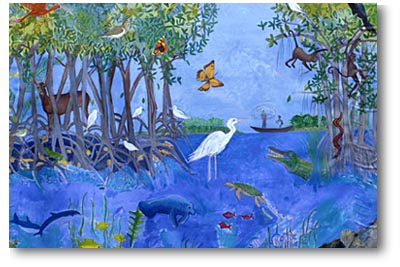
Mangrove Action Project |
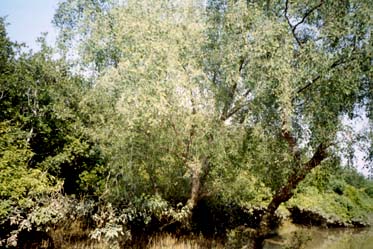
|
We now know that mangroves not only hold soil and actually create land at the edge of water; the also create clouds and rain. The dark foliage of the mangroves absorbs heat and causes warm, moist air to rise, forming clouds which precipitate. As mangroves are cleared, coastal area erode and dry out. Thus, mangrove and other rainforests protect continental ecosystems and climate, much as do the raft trees and seaswallowers of Shora. The continual deforestation on Earth is an growing crisis for our biosphere.
Sexuality
and Reproduction.
The
Sharers
of Shora are portrayed as biologically female, but pansexual; that
is, sexually or romantically attracted to people regardless of their
sex or gender. Their sexuality is
described obliquely as based on their sensitive hands and extra-long
fingers.
They reproduce by the "fusion of ova," a process that requires
extensive
management by the lifeshapers. The reason such intervention is
needed
is that eggs and sperm have different patterns of "imprinting,"
chemical
modification of the chromosomes. In order to combine two eggs,
one
of them would have to be entirely remodeled to provide the
imprinting patterns
of sperm.
Nevertheless,
Sharers
are human. A major project of Merwen's is to convince her
fellow Sharers that male Valans are human, too. Sharers remain
genetically
capable of interbreeding with Valan males, but their anatomy has
diverged
to the point where "standard" intercourse would be painful.
(This
kind of anatomical incompatability is common, for example, in widely
divergent
breeds of dogs.) Since Lystra has never seen male genitals
before,
she refers to that of Spinel as an "octopus arm," referring to the
special
genital arm of a cephaglobinid octopus.
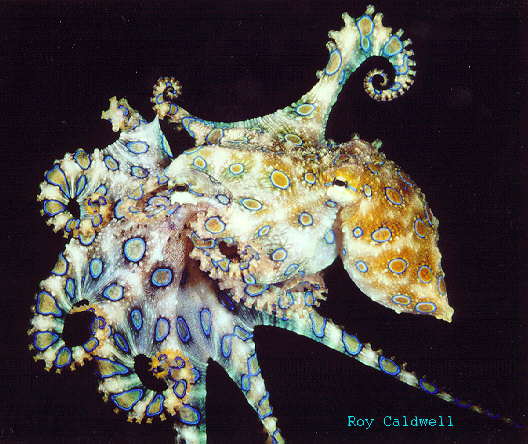 |
Two blue-ringed
octopi
mating. The male is on top and is using his
modified third
right arm, the
hectocotylus, to transfer sperm into the female's mantle. Species Hapalochlaena lunulata, photographed by Roy Caldwell. From The Cephalopod Page by James B. Wood. |
In order to develop a relationship with Lystra, Spinel ultimately has to become reconciled to her own Sharer ways of lovemaking, giving up the need to "put it inside." This choice is symbolic of the challenge men (and women) face in renouncing violence for nonviolent discipline. It is not however intended as a negative judgement on traditional heterosexual intimacy, as is clear in the subsequent books of the Elysium universe.
Quaker
traditions.
The
Sharer
society and religion has much in common with the Religious Society
of Friends, or Quakers. Quakers believe that God exists
infinitely
within every human being; and therefore, no group can suppress the
spirit
of any single individual. This means that within a Quaker
community,
all decisions must be made by "spiritual consensus," in concurrence
with
the spirit of all individuals--without exception. Thus one
individual
may have an exceptionally strong calling from God, preventing a
wrong action
by the entire group. This happens among the Sharers, when
Merwen
effectively blocks the will of a Gathering to use violence against
the
occupying soldiers. The Quaker (and Sharer) view of human
community
differs radically from American majoritarian democracy.
One might expect that the practice of consensus would produce an extremely conservative society. In some ways, Quaker society has been very conservative, particularly in the maintenance of peculiar dress and "plain speech" during the nineteenth century. In other respects, however, Quakers have been at the forefront of social change. Before the Civil War, Quakers across America achieved consensus on the evil of slavery--and fostered the Underground Railroad to undermine it. During the twentieth century, Quakers sent aid to victims of war and developed unique methods of helping development in impoverished nations, winning the Nobel Peace Prize for the American Friends Service Committee. They helped end the Cold War by promoting the Movement for a Nuclear Freeze--which came within two votes of winning support from Congress under President Reagan.
Nonviolent
political action.
Quakers,
and
other people throughout history, have successfully led political
revolts
and resistance through nonviolent action. A Door into
Ocean
is a virtual textbook of the methods of nonviolence. All the
incidents
of this book are based on actual historical events in which
nonviolent
methods were used. For a detailed and systematic historical
analysis
of nonviolent politics, see The
Politics
of Nonviolent Action by
Gene
Sharp. Some examples:
In my first completed manuscript, Merwen dies while attempting to rescue the Valan soldiers from the seaswallower. The intent of this portrayal was to evoke other non-violent leaders who died tragically, such as Gandhi and Martin Luther King. However, David Hartwell pointed out that the death of a female character in literature has unfortunate gendered associations that resonate very differently from the death of a male. Literary deaths of females more often evoke passive sacrifice or punishment for their own sins. In other words, there are more Iphegenias in literature than Joan of Arcs. So I changed this scene; Lystra swims out instead of her mother, and returns safely.
In
hindsight,
I would add that plenty of nonviolent leaders have gone on to
lead full lives; for example, the wives who got their Jewish
husbands back
from the Nazis, and the priest of Le Chambon. I think we are
brainwashed
with the idea that pacifists always get killed (and deserve
it.)
I now wish I had stuck to the original plan of Spinel and Lystra
going
on to Valedon, with the sequel to follow. It's hard to recall
the
constricted American vision of 1980, impoverished by bloated
military spending
and lack of attention to the needs of ordinary citizens. My
aim in
writing A Door into Ocean was to give students a window into
a hopeful
future. Ironically, it gives today's post-Cold War students a
look
back at our dark past; and a reminder that the struggle to defend
our planet
goes on.